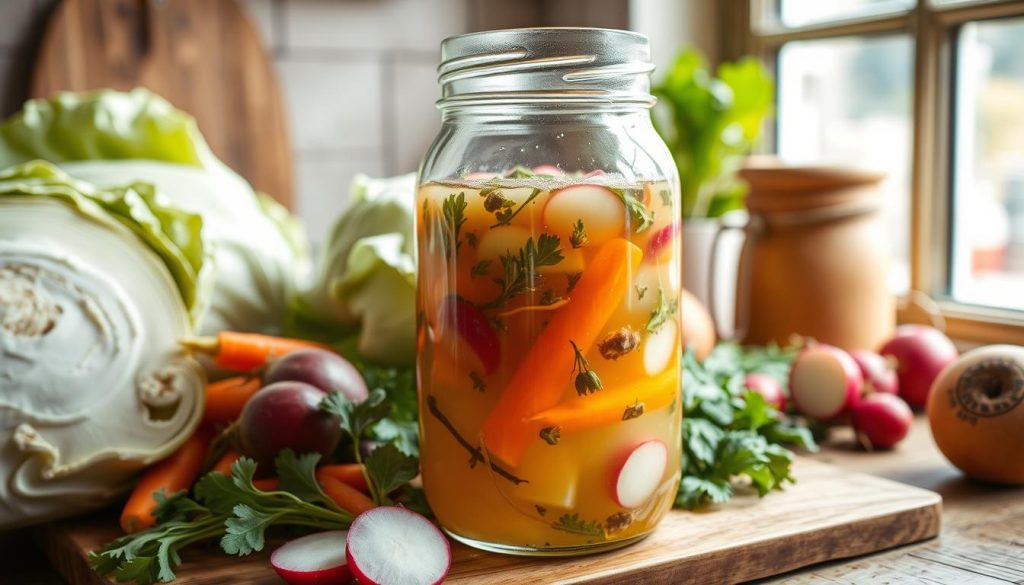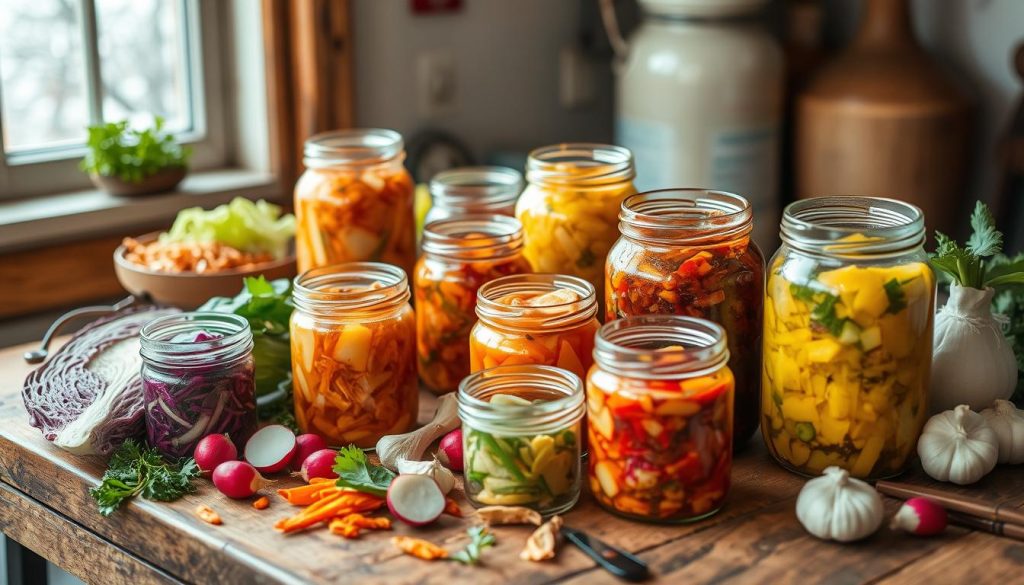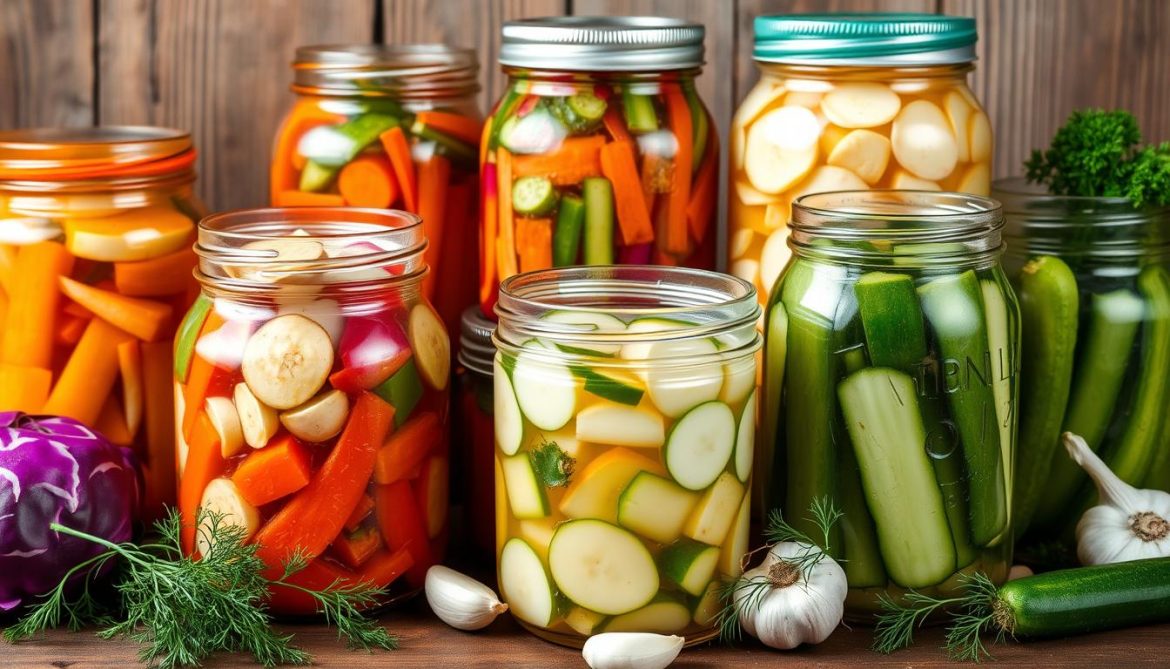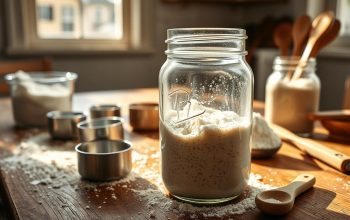As winter comes, keeping your immune system strong is key. Vegetable fermentation is a natural way to boost your health. Foods like sauerkraut, kimchi, and pickled veggies are full of good bacteria. These probiotics help your gut and immune system.
This article will show you how to make your own fermented veggies at home. You’ll learn about fermentation’s history and the science behind it. Whether you’re new to fermentation or already love it, you’ll find everything you need here. We’ll help you unlock the health benefits of these probiotic-rich foods.
Key Takeaways
- Fermented vegetables are a rich source of probiotics, which can support gut health and immunity.
- Discover the historical and cultural significance of fermentation across civilizations.
- Learn about the science behind lacto-fermentation and the role of lactic acid bacteria.
- Explore the best vegetables for fermentation and how to create the perfect brine solution.
- Gain a step-by-step guide to making your own fermented vegetables at home.
Understanding the Ancient Art of Vegetable Fermentation
Fermented foods have been a part of human life for thousands of years. Traditional preservation techniques like lacto-fermentation helped communities survive. This journey through history shows us the importance and evolution of vegetable fermentation.
The Historical Journey of Food Preservation
Fermentation has been around since humans first walked the earth. Early societies used microorganisms to keep food fresh. This method has shaped food traditions in many cultures, from ancient Egypt to China.
Cultural Significance Across Civilizations
Fermented vegetables hold special meaning in many cultures. In Korea, kimchi is a key part of their diet, showing their culinary heritage. In Europe, sauerkraut is loved, with each place having its own twist.
“Fermentation is not just a method of food preservation, but a celebration of cultural diversity and the enduring power of human ingenuity.”
Exploring fermented vegetable traditions reveals a deep connection. It shows how food, history, and human experience are intertwined. This highlights the timeless appeal of this ancient art.
Health Benefits of Consuming Fermented Foods
Fermented foods are known for their health benefits. These benefits come from probiotics, especially lactic acid bacteria. They help keep our gut healthy and improve our overall well-being.
Eating fermented probiotic foods boosts our digestion. These live cultures break down nutrients, making vitamins and minerals easier to absorb. This leads to better nutrient use and health in our gut.
Also, fermented foods strengthen our immune system. The lactic acid bacteria in these foods boost our body’s defenses. They help fight off harmful germs and lower the chance of getting sick.
“Fermented foods are a treasure trove of health-promoting compounds, and their impact on our well-being is truly remarkable.” – Dr. Sarah Johnson, Nutritionist
Adding fermented veggies like sauerkraut and kimchi to your meals is easy. It’s a simple way to get probiotics and support your health. There are many options, and the benefits of these foods are worth trying.
Essential Equipment and Tools for Fermentation
Fermentation is an ancient art that needs the right tools for success. Whether you’re new or experienced, the right containers and gear are crucial. They make a big difference in the fermentation process.
Must-Have Containers and Vessels
The key to fermentation is the right container. Choose non-reactive materials like glass, ceramic, or food-grade plastic. Metal containers can react with the acidic brine solution and change flavors.
Invest in fermentation jars or crocks. They often have airlock lids for gas exchange.
Special Equipment for Different Fermentation Methods
- Sauerkraut and Kimchi: Need a weight or pressing device to keep vegetables under the brine.
- Kombucha: Requires a vessel with a tight lid and a spigot for pouring.
- Sourdough: Needs a proofing basket or banneton to shape the dough.
Weighing and Measuring Tools
Accurate measurements are crucial for the perfect brine solution. Use a reliable digital scale for weighing. Also, use measuring cups and spoons for adding salt and water.
| Essential Fermentation Tools | Purpose |
|---|---|
| Glass, ceramic, or food-grade plastic containers | Provide a non-reactive environment for the fermentation process |
| Airlock lids or fermentation weights | Regulate gas exchange and keep vegetables submerged in the brine |
| Digital scale and measuring cups/spoons | Ensure accurate measurements for the brine solution and other ingredients |
| Specialty equipment (e.g., kombucha brewing vessel, sourdough proofing basket) | Accommodate the unique requirements of different fermentation methods |
Having the right tools and containers is key for successful fermentation. With the right equipment, you’ll make delicious fermented vegetables at home.
Best Vegetables for Fermentation Projects
Fermentation turns simple veggies into tasty, healthful foods. Some veggies are better than others for making sauerkraut and kimchi. Cabbage and radish are top picks for these dishes.
Cabbage is a favorite for its firm texture and sweet taste. It’s perfect for many flavors. Cucumbers add a nice crunch and taste great with spices. Carrots, beets, and radishes bring color and unique flavors to fermented foods.
- Cabbage: The quintessential ingredient for sauerkraut and kimchi
- Cucumbers: Offer a satisfying crunch and versatile flavor profile
- Carrots: Lend a natural sweetness and vibrant orange hue
- Beets: Infuse ferments with a bold, earthy flavor and deep purple color
- Radishes: Add a peppery punch and crunchy texture to pickled vegetables
Choose fresh, organic veggies for the best results. Avoid damaged or blemished produce. This ensures your fermentation project turns out great and is good for you.
| Vegetable | Ideal for Fermentation | Flavor Profile |
|---|---|---|
| Cabbage | Sauerkraut, Kimchi | Mild, slightly sweet |
| Cucumbers | Pickled Vegetables | Refreshing, crunchy |
| Carrots | Pickled Vegetables | Sweet, earthy |
| Beets | Pickled Vegetables | Robust, earthy |
| Radishes | Pickled Vegetables | Peppery, crunchy |
“Fermentation is the foundation of flavor, and the gateway to a healthier gut.”
The Science Behind Lacto-Fermentation
Lacto-fermentation is an old way to keep food fresh that’s now popular again. It uses lactic acid bacteria to turn veggies into tasty, healthy treats.
Role of Lactic Acid Bacteria
Lactic acid bacteria are key to lacto-fermentation. They grow well without oxygen. They turn veggies’ sugars into lactic acid, stopping bad bacteria from growing.
These bacteria also make good stuff like vitamins and enzymes. They make the veggies healthier and keep them safe to eat.
Understanding pH Levels and Salt Ratios
Getting the pH levels and salt ratios right is important. The veggies need a pH between 4.0 and 4.6. This keeps bad bacteria away and lets the good bacteria grow.
The brine’s salt level is also crucial. Using 2-3% salt helps the good bacteria and keeps the bad ones away.
Knowing how lacto-fermentation works helps make tasty, healthy veggies at home. It’s all about the right mix of lactic acid bacteria, pH, and salt.
Creating the Perfect Brine Solution
Making the perfect brine solution is key in fermentation. It makes your fermented veggies taste great and keeps them fresh. Let’s explore how to make the best brine for your projects.
The secret to a great brine is finding the right mix of salt and water. The salt level is important. It stops bad bacteria and helps good bacteria grow, which is crucial for fermentation.
| Vegetable | Salt Ratio (per 1 cup of water) |
|---|---|
| Cabbage | 1-2 tablespoons |
| Cucumbers | 2-3 tablespoons |
| Carrots | 1-2 tablespoons |
| Radishes | 1-2 tablespoons |
Choosing the right salt is also important. Use unrefined salts like Himalayan pink salt or sea salt. They add nutrients and flavor to your veggies.
Use clean, filtered water for the brine. Stay away from chlorinated tap water. Chlorine can stop good bacteria from growing.
The brine you make will depend on the veggies you’re fermenting. Try different salt levels and flavors to find what you like best.

With the right brine, you’re ready to make tasty, healthy fermented veggies. They’ll be good for you and taste amazing.
Step-by-Step Guide to Fermented Vegetables
Fermenting vegetables at home is a fun and tasty journey. It’s great for both beginners and experienced folks. This guide will help you make tasty, healthy vegetable fermentation projects in your kitchen.
Preparation Techniques
Start by getting ready. You’ll need clean, sterilized jars or fermentation crocks. Make sure your veggies are fresh and clean. Wash and trim them well, removing any bad parts.
Proper Vegetable Processing Methods
- Cut the veggies into the shape you like. Try to make them all the same size for even fermentation.
- Pack the veggies tightly into your jar, leaving a little room at the top.
- Make a brine by mixing salt and water. Pour it over the veggies to cover them.
- Use weights or lids to keep the veggies under the brine during fermentation.
Storage and Monitoring
Now, let the fermentation start. Keep your jar or crock in a cool, dark spot. Watch for signs of fermentation like bubbles or a tangy smell.
Fermentation time varies with temperature and recipe. It can take days to weeks. Be patient and don’t open the jar too often.
As fermentation goes on, you might see scum or mold. This is normal and doesn’t mean it’s spoiled. If you see something odd, check your research or ask a fermentation expert.
With practice and care, you’ll make tasty, healthy fermented veggies. They’ll make your taste buds happy and your body strong.
Common Mistakes to Avoid in Fermentation
Fermentation is an ancient way to preserve vegetables. It can be rewarding but also tricky. Knowing and avoiding common mistakes can help you make tasty, healthy pickled vegetables.
One big problem is contamination. If you don’t clean your tools and space well, bad bacteria can ruin your batch. Make sure everything is clean before you start.
Getting the salt-to-water ratio wrong is another mistake. If the salt is off, the bacteria won’t work right. This can make your pickled veggies taste bad or even be unsafe. Always check your recipe to get it just right.
- Not watching the temperature and humidity can also mess up your fermentation. Fermented foods need a steady environment to grow well. Check on them often and adjust their space as needed.
- Too much air can also be a problem. It can cause mold and other bad things. Use tight lids and airlocks to keep the air out.
Knowing these common mistakes and how to fix them can make your fermentation better. You’ll get delicious, healthy pickled veggies every time.
| Potential Issue | Preventative Measure |
|---|---|
| Contamination | Thorough sanitization of equipment and surfaces |
| Improper salt-to-water ratio | Refer to trusted recipes and guidelines |
| Inadequate monitoring and storage conditions | Regularly check and adjust temperature, humidity, and oxygen levels |
By fixing these common problems, you can make the most of your pickled vegetables. Enjoy the tasty, healthy results of your hard work.
Traditional Recipes for Sauerkraut and Kimchi
Fermented vegetables have been a staple in many cultures for centuries. Sauerkraut from Germany and kimchi from Korea are two famous examples. Let’s dive into their authentic recipes and methods.
Classic Sauerkraut Recipe
Sauerkraut is a tangy, crunchy cabbage dish loved in Germany for generations. The traditional recipe is simple but needs patience and detail. You’ll need:
- 1 head of green cabbage, finely shredded
- 2 tablespoons of sea salt
- A clean, wide-mouthed jar or crock
Start by massaging the cabbage with salt until it juices. Pack the cabbage tightly into your jar or crock, pressing out air pockets. Use a weight to keep it under the brine. Let it ferment at room temperature for 4-6 weeks, skimming off scum. Once it’s tangy enough, store it in cold storage and enjoy.
Traditional Korean Kimchi Method
Kimchi is a spicy, fermented vegetable dish central to Korean cuisine. You’ll need Napa cabbage, Korean radish, scallions, and a spicy paste of garlic, ginger, and chili powder.
- Soak the Napa cabbage in a salt brine for several hours, then rinse and pat dry.
- Mix the cabbage with the radish, scallions, and spicy paste.
- Pack the mixture into a clean, wide-mouthed jar, pressing down to remove air pockets.
- Cover the jar with a lid and let it ferment at room temperature for 3-7 days, depending on your desired level of tanginess.
- Once fermented, transfer the kimchi to cold storage and enjoy its complex, bold flavors.
Both sauerkraut and kimchi showcase the ancient art of vegetable fermentation. Try these traditional recipes to discover their unique tastes and health benefits.

Storing and Maintaining Your Fermented Foods
Keeping your homemade pickled vegetables fresh is key to enjoying their health perks all year. By using the right storage methods, you can keep your fermented foods tasty and healthy for longer.
Optimal Storage Conditions
For your pickled vegetables to stay good, store them in a cool, dark spot. The best temperature is between 55-65°F (13-18°C). Don’t let them get too much sunlight or have their temperature change a lot, as this can ruin their taste and texture.
Container Selection
- Choose airtight glass jars or ceramic crocks for your pickled vegetables. These keep the air out, which is good for fermentation.
- Make sure the containers are clean and sterilized before you use them. This stops bad bacteria from growing.
- Fill the jars with the brine solution you used to make them. This keeps the right pH level and keeps the veggies under the brine.
Long-Term Preservation
To keep your fermented pickled vegetables for even longer, you can can or freeze them. Canning seals in the flavor and texture. Freezing keeps them fresh without losing the traditional preservation techniques.
It’s important to check on your fermented pickled vegetables often. A bit of care and attention will let you enjoy your homemade treats for months.
Troubleshooting Fermentation Problems
Fermentation is a traditional way to preserve food, but it can sometimes face challenges. As you start making fermented vegetables, knowing how to solve problems is key. Let’s look at common spoilage signs and how to fix them to keep your fermentation going smoothly.
Identifying Signs of Spoilage
It’s important to watch your fermentation closely to keep your food safe and tasty. Look out for these signs of spoilage:
- Mold growth – This shows up as fuzzy, colored spots on the ferment’s surface.
- Off-flavors – If your ferment tastes sour, bitter, or bad, it might be spoiled.
- Slimy or mushy texture – A good ferment should be firm and crisp.
- Excessive gas production – Too much bubbling or frothing means the fermentation process is off balance.
Solutions for Common Issues
Most fermentation problems can be fixed with a few easy changes. If you see any of these signs, try these fixes:
- Mold growth – Remove and throw away the moldy parts. Make sure your fermenter is sealed well and in the lactic acid bacteria-rich brine.
- Off-flavors – Change the salt level or fermentation time to fix the taste.
- Slimy or mushy texture – Add more salt or let it ferment longer to get the right crispness.
- Excessive gas production – This means the fermentation environment is out of balance. Adjust the salt, temperature, or air flow to fix it.
With a bit of troubleshooting and patience, you can overcome these common problems. This way, you can enjoy the tasty results of your homemade fermented foods.
Incorporating Fermented Foods into Your Daily Diet
Adding fermented foods to your meals is easy and tasty. It helps improve your gut health and overall health. You can enjoy tangy sauerkraut or creamy yogurt in many dishes.
Begin your day with kimchi on your breakfast or Greek yogurt in your smoothie. For lunch, add pickled carrots or fermented beets to your sandwich or salad. Enjoy a bowl of miso soup or roasted Brussels sprouts with probiotic dressing for dinner.
Experts say to eat 1-2 servings of fermented foods daily for better gut and immune health. Making these probiotic foods a part of your diet should be fun. Try out new fermented vegetable recipes and flavors.



